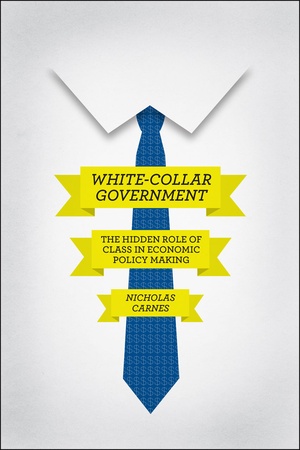Congress has very few working class members. Here’s why that matters

I spend a lot of time thinking about the pressures that members of Congress face when they are in office, and the rich donors who fund their campaigns. But after reading Nicholas Carnes’ new book, White-Collar Government, I wonder if maybe I should be thinking more about who runs for office in the first place. Because while members sure hear from a lot of millionaires outside of Congress, they also hear from many millionaires inside Congress too – namely, themselves. (More than half of sitting members of Congress now have $1 million or more to their names).
The book’s thesis is simple and straightforward: If you elect mostly wealthy representatives, you’ll get policy that represents the interests of the well-off. Or, as Carnes puts it in the converse logic: “[T]he shortage of people from the working class in American legislatures skews the policy-making process toward outcomes that are more in line with the upper class’ economic interests.”
About two percent of members of the U.S. Congress came from a working-class occupation. About three percent of the average state legislature and about nine percent of the average city council also come from a working-class background. But more than half (54 percent) of U.S. citizens are in working-class jobs. Something is off. And this distortion has real effects on policy.
White-Collar Government documents what you might have already guessed: that working-class representatives tend to be more concerned about working-class issues. They have more progressive voting records, and they introduce more progressive economic legislation.
But Carnes’ key contribution is showing how that translates into outcomes. State legislatures, those laboratories of democracy, vary in both the share of representatives who come from blue-collar jobs, and the share of state funding allocated to social programs. It turns out the two are correlated. In Maine, for example, one in seven representatives come from blue-collar jobs (making it the most working-class state legislature). It devotes 30 percent of its budget to social programs – one of the highest rates of any state. By contrast, states with higher percentages of business owners tend to have less generous support for unemployment, and lower corporate tax rates. As Carnes summarizes his findings:
The effects on the well-being of working-class Americans are staggering. Business regulations are more relaxed, tax policies are more generous to the rich, social safety net programs are stingier, and protections for workers are weaker than they would be if our political decision makers came from the same mix of classes as the people they represent.
One way to assess the challenge that working-class lawmakers face is to look at how hard they work to get their legislation passed. Carnes finds that they work very hard. They tend to introduce progressive economic legislation, and then generate many more co-sponsors than their non-working class colleagues. Yet “the bills they introduce are killed off at an exceptionally high rate.”
Carnes suggests that one reason for their comparative lack of success is that few other members of Congress – and for that matter, relatively few people in Washington — share that same progressive economic worldview because they just can’t relate to those concerns. They’ve always had it relatively easy, and never lived paycheck to paycheck. Carnes asks a very good question: “What happens when a social group has few or no advocates in our policy-making process, when almost no one in government truly understands the group’s needs or perspectives?” The answer, of course, is that they fare poorly.
Finally, there is the question of what to do about it. Carnes’ suggestion is straightforward: Get more working-class people to run for office. Of course, there are challenges. As Carnes notes, “What little evidence there is suggests that blue-collar workers are underrepresented not because of some deficiency on their part, but because of discouraging circumstances, like the high cost of running a campaign, the practical burdens associated with holding office, and the gate-keeping decisions of party leaders and interest groups.”
Running for Congress is insanely expensive. To be taken seriously as a candidate, you need to raise significant sums of money. I suspect this simple fact keeps many working class aspirants out of politics. Rich people tend to have rich friends who will support them. Working class people, not so much.
My (obligatory criticism here) concern with White-Collar Government is that, while it is obviously a reaction to too much focus on the outside pressures that Congress faces, the book doesn’t engage much with those outside pressures. It would be interesting to know, for example, if business interests ignore blue-collar members of Congress entirely, or do they try to bring them around to more pro-business views through the usual mix of lobbying and campaign contributions. Are blue-collar members and their staff less likely to become lobbyists when they leave Congress? More broadly, what correlations exist between the backgrounds of members of Congress and the particular interests for whom they advocate within the Congress?
Overall, though, White-Collar Government stands a sober reminder of why it matters whether Congress is a millionaires’ club, and why we should all probably be paying a little more attention to who gets to make the decisions for the country (not just who is in the room with them).
White-Collar Government is a great (and pretty quick) read, so it’s definitely worth getting a copy. Fortunately, it is on sale for a relatively blue-collar price, at least as far as academic press books go.
Also, because lawmakers’ personal backgrounds may actually be relevant to understanding the decisions they make, you should check out Sunlight’s tool for exploring the background of senators. Note: Of the 100 Senators, just seven reported personal assets at less than $100,000. Thirty are between $100,000 and $1 million; 42 are between $1 million and $10 million and 19 are over $10 million. Three report more than $100 million in assets: Sens. Mark Warner, D-Va., Jay Rockefeller D-W.Va., and Richard Blumenthal, D-Conn.

